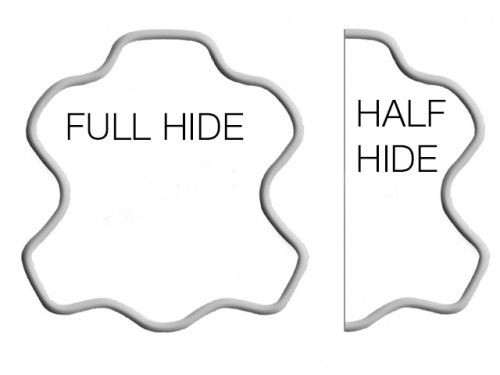Difference between revisions of "Measures and weights"
| Line 5: | Line 5: | ||
==Units of measurement in leather== | ==Units of measurement in leather== | ||
| − | [[Leather]] is not in metres coming from a roll. For this purpose, the [[Parts of the hide|external contours of the animal skin]] are too irregular. Leather is measured and calculated in square meters, | + | [[Leather]] is not in metres coming from a roll. For this purpose, the [[Parts of the hide|external contours of the animal skin]] are too irregular. Leather is measured and calculated in square meters, decimetres, square feet (inch: inches), lengthwise or in kilograms. We also speak of weight leather and surface leather. [[Leather straps#Leather straps - Leather laces|Leather laces]] are sold by length. |
Not always the total surface of a skin is sold. As the leather [[Hide - Skin|skin]] has different [[leather quality|qualities]] within a skin, these are sometimes cut in [[Parts of the hide|parts]] with different qualities. There are corresponding technical terms for these [[Parts of the hide|sections]]. | Not always the total surface of a skin is sold. As the leather [[Hide - Skin|skin]] has different [[leather quality|qualities]] within a skin, these are sometimes cut in [[Parts of the hide|parts]] with different qualities. There are corresponding technical terms for these [[Parts of the hide|sections]]. | ||
| Line 11: | Line 11: | ||
==Leather surface measurement== | ==Leather surface measurement== | ||
| − | Large [[Hide - Skin|skins]], such as [[Cow leather|bovine skins]], are measured in square meters (m²). Occasionally, | + | Large [[Hide - Skin|skins]], such as [[Cow leather|bovine skins]], are measured in square meters (m²). Occasionally, decimetres (dm²) are indicated. A [[Cow leather|cattle skin]] usually has 4.5 to 5.5 square meters. There are also larger (up to 6 sqm) and smaller skins. [[Leather dealer|Leather dealers]] mostly sell complete and half skins. For certain purposes, [[Leather cutting|further sections]] of the animal skin are sold. Smaller [[Leather cutting|sections]] are reluctantly sold. The [[leather cutting waste]] is then too much. |
| Line 22: | Line 22: | ||
</p> | </p> | ||
<p align=center> | <p align=center> | ||
| − | ''For large hides, the measure is usually square meters. However, | + | ''For large hides, the measure is usually square meters. However, decimetres are also given.''<br></p> |
<p> </p> | <p> </p> | ||
| Line 56: | Line 56: | ||
==Leather by weight== | ==Leather by weight== | ||
| − | Heavy leather, such as [[leather shoes#Sole leather|sole leather]], [[leather straps]] and [[bridle]] is calculated by weight. | + | Heavy leather, such as [[leather shoes#Sole leather|sole leather]], [[leather straps]] and [[bridle]] is calculated by weight. Also [[leather cutting waste]] is usually measured in kg. |
==Leather according to length== | ==Leather according to length== | ||
| − | [[Reptile leather]] | + | [[Reptile leather]] is calculated by length. |
==[[Thickness of leather|Leather thickness]]== | ==[[Thickness of leather|Leather thickness]]== | ||
| − | The [[Thickness of leather|leather thickness]] is measured in | + | The [[Thickness of leather|leather thickness]] is measured in millimetres with special measuring instruments. |
| Line 80: | Line 80: | ||
</p> | </p> | ||
<p align=center> | <p align=center> | ||
| − | ''Leather can be over 6 mm [[Thickness of leather|thick.''<br></p> | + | ''Leather can be over 6 mm [[Thickness of leather|thick]].''<br></p> |
<p> </p> | <p> </p> | ||
Revision as of 20:06, 2 February 2017
Contents
Units of measurement in leather
Leather is not in metres coming from a roll. For this purpose, the external contours of the animal skin are too irregular. Leather is measured and calculated in square meters, decimetres, square feet (inch: inches), lengthwise or in kilograms. We also speak of weight leather and surface leather. Leather laces are sold by length.
Not always the total surface of a skin is sold. As the leather skin has different qualities within a skin, these are sometimes cut in parts with different qualities. There are corresponding technical terms for these sections.
Leather surface measurement
Large skins, such as bovine skins, are measured in square meters (m²). Occasionally, decimetres (dm²) are indicated. A cattle skin usually has 4.5 to 5.5 square meters. There are also larger (up to 6 sqm) and smaller skins. Leather dealers mostly sell complete and half skins. For certain purposes, further sections of the animal skin are sold. Smaller sections are reluctantly sold. The leather cutting waste is then too much.
For large hides, the measure is usually square meters. However, decimetres are also given.
In the tannery, computer measure the size of the skin at the end of the leather production.
Full hide - Half hide. The division takes place along the back line.
Lamb, pork and goatskin in the clothing sector are usually measured in square feet or square inch.
The conversion factor for the conversion from square meters to square feet is 10,764, from square meters to square inch 1550,003.
Example:
2,95 square meters x 10,764 = 31,75 square feet
45 square feet : 10,764 = 4,18 square meters
In case of leathers, where the surface is paid, the tanner has a great interest in reaching an as large as possible surface during tanning process.
Leather by weight
Heavy leather, such as sole leather, leather straps and bridle is calculated by weight. Also leather cutting waste is usually measured in kg.
Leather according to length
Reptile leather is calculated by length.
Leather thickness
The leather thickness is measured in millimetres with special measuring instruments.
Measurement of leather thickness.
Leather can be over 6 mm thick.
Additional information
WE UNDERSTAND LEATHER - WWW.COLOURLOCK.COM
[Kategorie:All Articles]]




















 a kotori web solution
a kotori web solution